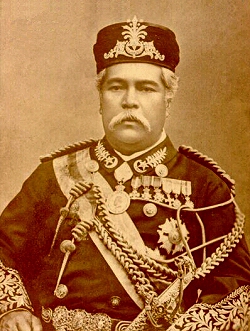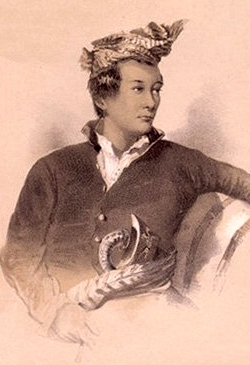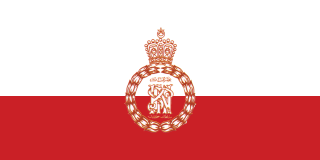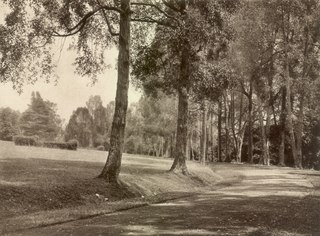Related Research Articles

Tengku Alam Shah, Tengku Ali Iskandar Shah was a prince of the House of Bendahara (Johor), and was the oldest son of Sultan Ali, the 19th Sultan of Johor by his second wife, Daing Siti. Following his father's death in 1877, Tengku Alam and his supporters made an active pursuit to his claims for the Kesang territory and was publicly proclaimed as the Sultan of Johor and Pahang with the regnal name of Alauddin Alam Shah during his marriage ceremony in 1879.

Sultan Sir Abu Bakar Al-Khalil Ibrahim Shah ibni Almarhum Maharaja Tun Daeng Ibrahim was the Temenggong of Johor. He was the 1st sultan of modern Johor, the 21st Sultan of Johor and the first Maharaja of Johor from the House of Temenggong. He was also informally known as "The Father of Modern Johor", as many historians accredited Johor's development in the 19th century to Abu Bakar's leadership. He initiated policies and provided aids to ethnic Chinese entrepreneurs to stimulate the development of the state's agricultural economy which was founded by Chinese migrants from southern China in the 1840s. He also took charge of the development of Johor's infrastructure, administrative system, military and civil service, all of which were modelled closely along Western lines.
Telok Blangah is a subzone region and housing estate located in the area behind Keppel Harbour in Bukit Merah, Singapore. Teluk Blanga is the district between Pasir Panjang and Tanjong Pagar.

The Sultan of Johor is a hereditary seat and the sovereign ruler of the Malaysian state of Johor. In the past, the sultan held absolute power over the state and was advised by a bendahara. Currently, the role of bendahara has been taken over by first minister with the constitutional monarchy system via Johor State Constitution. The sultan is the constitutional head of state of Johor. The sultan has his own independent military force, the Royal Johor Military Force. The sultan is also the Head of Islam in Johor state.

Sultan Ali Iskandar Shah I ibni almarhum Sultan Ahmad Hussein Muazzam Shah I was the 20th Sultan of Johor, who succeeded his father, Sultan Hussein Shah after the latter died of natural causes in 1835. Over the next twenty years, Sultan Ali's claim to being the Sultan of Johor were only recognised by some merchants and a few Malays. Like his father, Sultan Ali was a puppet monarch and played a minimal role in the administrative affairs of the state, which came under the charge of the Temenggong and the British. In 1855, Sultan Ali ceded the sovereignty rights of Johor to Temenggong Daeng Ibrahim, in exchange for formal recognition as the "Sultan of Johor" by the British and a monthly allowance. Following the secession of Johor, Sultan Ali was granted administrative charge over Muar until his death in 1877, and in most administrative matters, was often styled as the "Sultan of Muar".

Jaafar bin Haji Muhammad D.K., S.P.M.J., C.M.G. was the first and longest serving Dato' Menteri Besar of the independent kingdom of Johor, an office he held from 1886 until his death.

Bidadari Cemetery is a defunct cemetery in Singapore. It used to serve the Christian, Muslim, Hindu and Sinhalese communities, and accepted burials between 1907 and 1972. The site of Bidadari Cemetery used to be Istana Bidadari, the home of Che Puan Besar Zubaidah, who was the second wife of Sultan Abu Bakar of Johor Istana.

Masjid Temenggong Daeng Ibrahim, also known as Masjid Diraja Telok Blangah, is a historical royal mosque that is located along 30 Telok Blangah Road in Telok Blangah within Bukit Merah, Singapore.
Makam Diraja Johor Telok Blangah is a Johor royal mausoleum co-located next to the grounds of Masjid Temenggong Daeng Ibrahim in Telok Blangah, Singapore. The royal cemetery is the final resting place of the descendants of the House of Temenggong from 1825 to 1900.

Istana Bukit Serene is the royal palace and official residence of the Sultan of Johor, located in Johor Bahru, Malaysia. The palace faces the Straits of Johor and has a bird's eye view of Singapore, a former possession of the sultanate.

The Sultan of Kelantan is the constitutional head of Kelantan state in Malaysia. The executive power of the state is vested in him as the monarch of the state. The current sultan, Muhammad V, is the 29th Sultan of Kelantan. He is the Head of Islam in the state and the source of all titles, honours and dignities of its people. He was the 15th Yang di-Pertuan Agong or the monarch and head of state of Malaysia from 13 December 2016 to his abdication on 6 January 2019, after his election on 14 October 2016 at the 243rd (special) Conference of Rulers.

Wong Ah Fook J.P.,, also known as Wong Fook (黄福) or Wong Fook Kee (黄福基), was a Chinese immigrant, entrepreneur, and philanthropist who left an indelible imprint on the state of Johor in present-day Malaysia, particularly its capital, Johor Bahru. Primarily a building contractor, although he also ventured into many other businesses, he built a good number of Johor's heritage buildings, including the original Istana Besar, the royal palace of the Sultan of Johor. Jalan Wong Ah Fook, one of the busiest streets in downtown Johor Bahru, is named after him.

Bidadari is a housing estate and a subzone of Toa Payoh planning area, in the Central Region of Singapore.

Istana Woodneuk is an abandoned two-storey palace at the former Tyersall Park, bounded by Holland Road and Tyersall Avenue, near the Singapore Botanic Gardens in Singapore. Before it was rebuilt in 1935 it was known as Istana Woodneuk. It suffered a major fire in 2006 and has been deemed beyond repair. The remains of the palace, as well as the land it sits on, is private land belonging to the State of Johor. It is not charted on most modern maps and is currently not accessible to the public. The grounds, including Tyersall Park, are plotted on Google Maps but are marked as "Permanently closed".

Tyersall Park is an estate in Singapore, bound by Holland Road and Tyersall Avenue, and near the Singapore Botanic Gardens. Previously a private land belonging to the Sultan of Johor from 1862, some portions of it had been acquired by the Government of Singapore in 1990 and in 2009 respectively.

Istana Tyersall is a demolished historical palace that used to be in the former Tyersall Park bound by Holland Road and Tyersall Road near the Singapore Botanic Gardens in Singapore. The land it was formerly built on is currently restricted from the public.

The Istana Lama was a palace once located at Telok Blangah in Singapore. It was first built for Temenggong Abdul Rahman in 1824. It had since been demolished in 1954.
Foreign territories in Singapore are the plots of land owned by other countries in the Republic of Singapore. There are currently only two separate pieces of land in the country which fall under this category, both of which are owned by Malaysia and fall under its extraterritorial jurisdiction. The foreign territories in Singapore do not include diplomatic missions, like embassies and high commissions operated by other countries in the republic, because contrary to popular belief, diplomatic missions do not exercise full sovereign rights of the respective countries but only enjoy certain immunity of local laws. Several other Singapore rules and laws still apply in these areas, and Singapore reserves full rights to suspend or expel diplomatic missions in the country without compensation.

Temenggong Tun Daeng Ibrahim bin Almarhum Temenggong Tun Daeng Abdul Rahman was the Temenggong of Johor and later the de facto Maharaja of Johor from 1855 to 1862.
In Singapore, there are numerous cemeteries that house Muslim graves. Many of them are not in use currently as most of the burials take place at Pusara Aman in Choa Chu Kang. This is a non-exhaustive list of the Muslim cemeteries that have been demolished such as Bidadari Cemetery, as well as cemeteries that have not been in use for years. Included in this list are Keramats (Mausoleums) that are present in Singapore.
References
- ↑ "THE LATE MR. H.M. SIMONS". eresources.nlb.gov.sg. Retrieved 2019-04-11.
- ↑ "Kesultanan Johor: ISTANA BIDADARI". Kesultanan Johor. Retrieved 2019-04-23.
- ↑ "History of the Johor Sultanate". Datodatuk. Retrieved 2019-04-17.
- ↑ "Bidadari Memorial Garden". www.roots.sg. Archived from the original on 2019-04-11. Retrieved 2019-04-11.